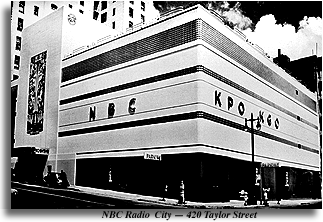|
||||
|
||||
|
|||||||||||||||||||

Each of the 10 studios in the new NBC building at Taylor and O’Farrell streets will be like a huge box within a larger box, supported and suspended on springs which will absorb sound and vibration from the main building structure. This was one of many interesting announcements made by O.B. Hanson, vice president and chief engineer of the National Broadcasting Company, New York, who just arrived in San Francisco to supervise some of the technical plans and work in connection with the improvement.
Hanson was greeted at the train by a large delegation from KGO and KPO, for which the
new million-
Each studio, Hanson explains, is to be set on springs, the walls and ceilings suspended by springs, not fixed to the side pillars of the building. These springs will absorb the outside vibration and sound so that it can’t possibly get into the studio. Beyond this, the walls of the studios must have special acoustical treatment so the notes of a trumpet or soprano will not bounce around like they would off of ordinary wall surfaces, according to Hanson. “We have learned a great deal about building studios in the 14 years NBC has been sending its programs to the radio audience,” said the visiting executive. “The new KGO-KPO studios will have the benefit of everything we have learned. We of the NBC engineering department expect the facilities in the new building to be tops in the broadcasting world.”
Hanson also explained the value of air conditioning in the studios. “Even slight changes in either temperature or humidity affect the true pitch of delicate musical instruments. In properly air conditioned studios all the instruments will stay on pitch even after they have been tuned. This air conditioning will be installed through all offices, conference and other rooms in the building for the comfort of the employees.” Keeping programs on the air is only half the engineering job, according to the expert. The other half is the constant development of technical methods of making programs better for the listener. This requires constant improvement of equipment so the audience hears exactly what the various artists send out. The new building, Hanson says, will employ every device engineering science has developed for the efficiency of broadcasting. For example, the new master control desk will enable one man to have complete control of every studio, every line in and out of the building, all the switches, changes and operations. He will be like a train dispatcher who has control of the movements of all the trains.
At present KGO, KPO and each of the Northwest NBC stations, all of which are routed through San Francisco, has an individual button which must be punched in order to send the right programs to the proper outlets and only five seconds are allowed for the punching of these buttons. Naturally there is a chance of error.
In the new studios a new master preset will permit the switching to be made during the
15-minute period before it is to become effective. When chimes ring at the switching time,
only one button will need to be punched. The pre- Engineers are looking ahead of immediate requirements and making provisions for the addition of television facilities when the time comes for that service on the Coast. San Francisco Chronicle Sunday, November 24, 1940 |